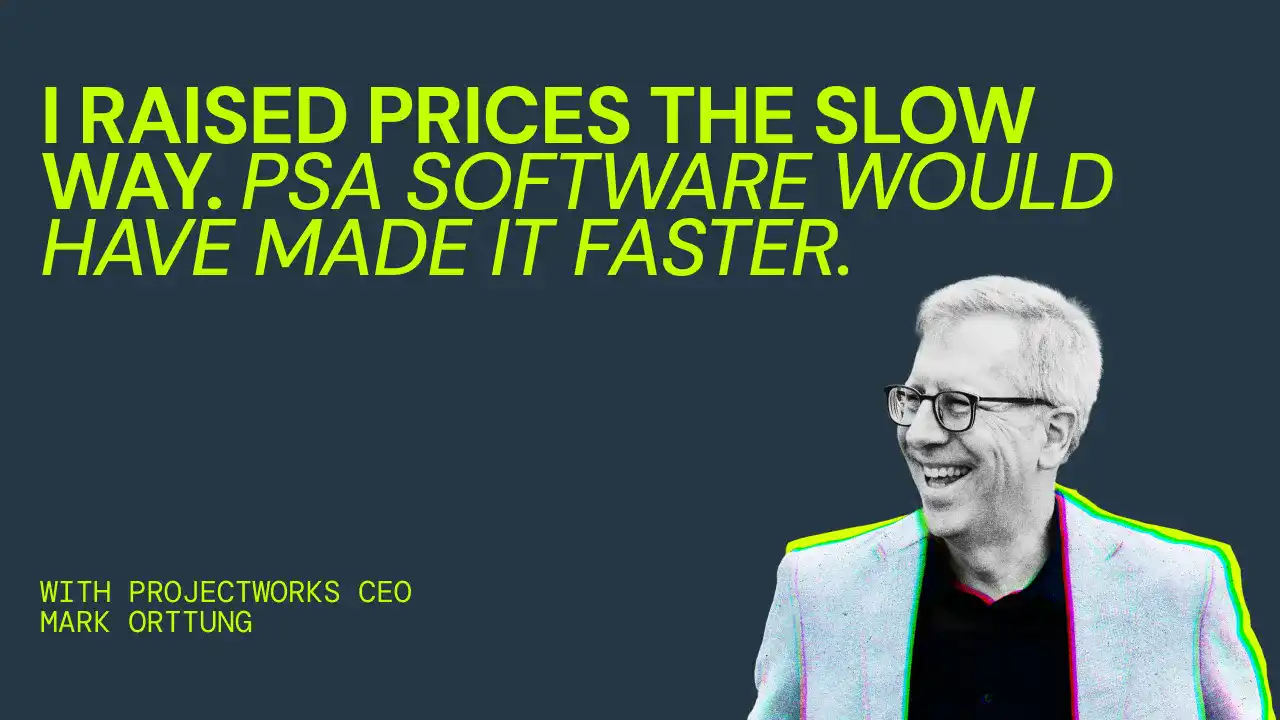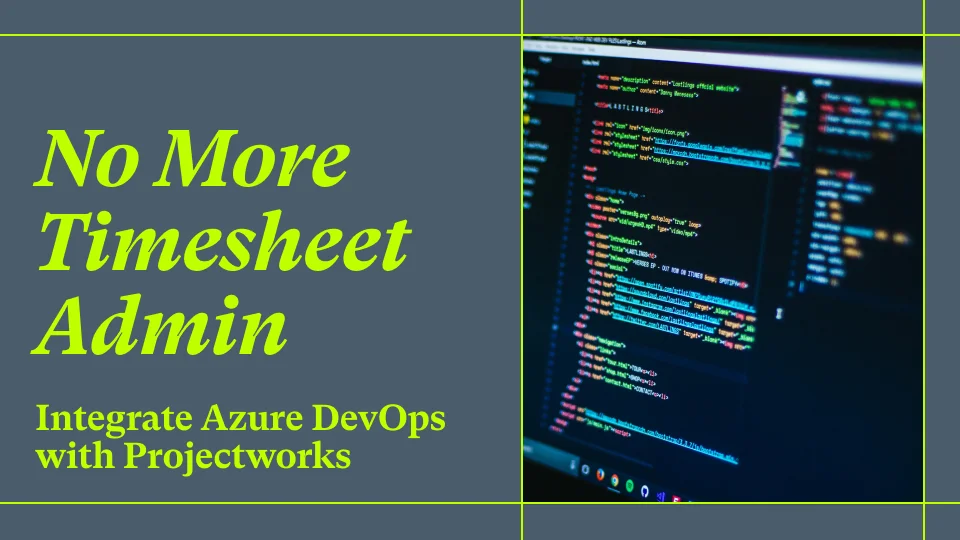I Raised My Firm’s Prices The Slow Way. Here’s How PSA Software Would Have Made It Faster.

We doubled billable rates at consulting firm Nexient during my tenure as CEO - but it took us 7 years. In hindsight we could have lifted prices so much faster with a Professional Services Automation tool. Instead we had our field team.
Our field team was a talented group of client partners and general managers. Every new bid required one of them to vanish into a maze of spreadsheets to figure out what we should charge for the next proposal. We had the right instincts, but without the live pricing insights you get from a PSA tool, we were flying blind.
Here’s how a PSA tool like Projectworks would have helped us raised prices faster, with more confidence, and with far less friction inside the firm.
Why Underpricing Happens When You Don’t Have PSA software
If you’re like most consulting leaders we speak to at Projectworks, your pricing process looks something like mine used to:
- A rate card that only gets revisited once in a while
- A folder of “similar” proposals people copy and tweak
- A spreadsheet or two that one or two “numbers people” understand
- A healthy dose of gut feel from whoever is scoping the work
It sort of works. You stay in the market. You win enough work. You might even grow.
But this approach has three big weaknesses when it comes to lifting prices:
- You are always looking backward. The numbers you are using are weeks or months old by the time they show up in a spreadsheet.
- You are relying on a few heroes. Each proposal is driven by the person closest to the client - but they don't have time to catch up on all the latest pricing intel from across the firm.
- You don't really know where you are underpricing. You have hunches, but you can’t show your partners or clients hard evidence.
From Gut Feel To Data-Based Pricing
At its core, a professional services automation tool like Projectworks pulls together the operational reality of your firm:
When you have all of that in one place, you get three things I wish we had when we were trying to lift our rates:
- You can spot underpriced work more clearly - and make better future pricing decisions based on it.
- You standardize pricing decisions across your firm - rather than reinventing the wheel for every proposal.
- You can model a price rise before you make it - and make more courageous pricing calls.
Here’s how they would have got me to raise prices faster:
Three Ways PSA Software Can Speed Up Raising Prices
1. Live Project Reporting Helps You Spot Underpriced Work Faster
In our firm, we had a sense that certain clients and project types were more or less valuable than others. But those were anecdotes, not facts.
With a PSA tool, I would have seen, in real-time:
- Actual hours vs scoped hours
- Margin by client, project, and service line
- Where write offs and scope creep were silently eroding profit
That live project reporting does two things:
- It gives you a priority list for price increases.
- It allows you to frame price changes around specific patterns, not gut-feel.
You are no longer saying, “We should probably raise prices.” You are saying, “Every transformation project of this type has delivered at a realized rate 20 percent below our target. We either need to change the model or change the price.”
I used the Three Arcs model to double Nexient’s rates, but it would have been immensely easier to implement if we’d had this kind of real-time project reporting data.
2. You Standardize Pricing Decisions, Instead Of Reinventing Them
One of the reasons our client partners had to disappear into the spreadsheets so often is that every project opportunity felt unique.
The truth is, most of your work is not that unique. It falls into recognizable patterns. A PSA tool helps you capture and standardize those patterns:
- Typical team mix and duration for a given type of project
- Expected utilization and ramp up time
- Average margin and risk profile
- Common scope changes and their impact
Once those patterns are visible, you can build:
- Standard project templates with realistic estimates
- Clear rate cards aligned to actual delivery, not wishful thinking
- Guardrails for discounts and exceptions
Now, instead of every opportunity triggering a fresh pricing debate, most of them follow a consistent, transparent logic. You save your energy for the few deals that genuinely need special treatment.
That consistency makes it much easier to update pricing. When you adjust a rate in the system, you know exactly which templates, proposals, and forecasts it affects. You are changing the system, not hacking one-off deals.
3. You Can Model The Impact Of Price Lifts Before You Make Them
When we doubled our rates over several years, every step felt like a leap of faith. We would increase prices for new clients or new offerings, then wait a quarter or two to see what happened.
A PSA tool gives you the ability to do “what if” thinking with real data:
- What happens to next quarter’s revenue if we lift rates on this service by 10 percent and lose 10 percent of volume?
- How does profitability change if we hold headline rates but reduce discounting by a few points?
- If we shift our mix toward higher-margin services, what does that do to our effective rate?
You can test scenarios using current project resourcing, actual utilization, and real margins rather than abstract spreadsheets.
That matters, because courage to raise prices often comes from seeing the numbers before you make the call. When partners can see that a modest rate increase in a few specific areas could materially improve profit, they are much more willing to act.
More Courageous Pricing Calls, Backed By PSA Software Evidence
Raising prices is rarely a purely rational decision. It triggers fear:
- Fear of losing good clients
- Fear of missing targets
- Fear of upsetting the team
I felt those fears every day of those seven years we weredoubling prices at Nexient. Data wouldn’t have made those fears vanish, but it would have given us a single source of truth to make faster more confident decisions.
With Professional Services Automation software:
- You can show that certain clients are paying below-market rates and consuming above-average effort.
- You can prove that particular services routinely deliver significant value that is not reflected in current pricing.
- You can demonstrate how often your teams are working beyond scope for free.
That turns conversations about pricing from “Are we being greedy?” to “Are we running this business responsibly, given what the data is telling us?”
For me, that is the biggest win. PSA software buys you courage by giving you evidence.
See how Projectworks ranks in the Top 10 Professional Services Automation Software options.
Why I Chose Projectworks Professional Services Automation Software
When I first saw Projectworks, it was hard not to think back to all the hours our client partners had spent buried in spreadsheets.
I realized that if we had had a PSA platform like this:
- We would have seen underpriced work much earlier.
- We would have moved away from one-off heroics and toward consistent, systemized pricing.
- We could have doubled our rates faster, with less strain on the team.
That was one of the many reasons I decided to join Projectworks as CEO.
PSA software will not make the tough calls for you. You still have to decide when to say no to bad work, when to hold your nerve on a price, and when to back your own value. But it will give you what we did not have enough of at the time: a clear, current, shared picture of how your consulting business really works.
And once you have that, raising prices stops being a leap of faith and becomes a series of informed, intentional steps. Book a demo with our team today, and get the clarity and confidence to double your firm’s prices.
Related Articles

Managing Clients With Salesforce and Your Professional Services Automation Software: A Consultant's Guide
Discover how integrating Salesforce with your professional services automation software helps consulting firms streamline delivery, manage resources, track time & expenses, and improve invoicing accuracy.

No More Timesheet Admin for Software Specialists: Integrate Azure DevOps with Projectworks Time Tracking Software
Do you run a software services consultancy? Maybe you’re a delivery lead and struggling to track your employees' time accurately? If so, you probably know the pain of chasing timesheets, patching data together across tools, or realizing - too late - that your project burn has outpaced your budget.

Projectworks vs. ROLL: Setting the Record Straight on Professional Services Automation Software
When competitors compare, accuracy matters. Recently, our friends over at ROLL published a page inviting people to “switch from Projectworks” and implying that Projectworks is little more than a timesheet tracker. We love a bit of competition between professional services tools - but not when fiction replaces fact! So, let’s clear the air and have a little fun while we’re at it 😉👇